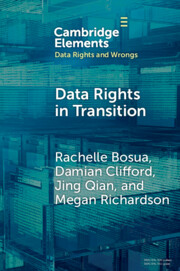Refine search
Actions for selected content:
48556 results in Computer Science

Data Rights in Transition
-
- Published online:
- 08 August 2025
- Print publication:
- 04 September 2025
-
- Element
- Export citation
Memory and anxiety: A sociocultural approach: Introduction to the Special Collection
- Part of
-
- Journal:
- Memory, Mind & Media / Volume 4 / 2025
- Published online by Cambridge University Press:
- 08 August 2025, e9
-
- Article
-
- You have access
- Open access
- HTML
- Export citation
MODULAR SEQUENT CALCULI FOR INTERPRETABILITY LOGICS
- Part of
-
- Journal:
- The Review of Symbolic Logic / Volume 18 / Issue 3 / September 2025
- Published online by Cambridge University Press:
- 08 August 2025, pp. 704-743
- Print publication:
- September 2025
-
- Article
- Export citation
Measuring resilience in national food systems using “food systems resilience score”
-
- Journal:
- Data & Policy / Volume 7 / 2025
- Published online by Cambridge University Press:
- 08 August 2025, e54
-
- Article
-
- You have access
- Open access
- HTML
- Export citation
Tables
-
- Book:
- The Cambridge Handbook of Generative AI and the Law
- Published online:
- 08 August 2025
- Print publication:
- 07 August 2025, pp xi-xii
-
- Chapter
- Export citation
2 - The Concept of Paradata
-
-
- Book:
- Paradata
- Published online:
- 05 August 2025
- Print publication:
- 07 August 2025, pp 11-39
-
- Chapter
-
- You have access
- Open access
- HTML
- Export citation
Foreword
-
-
- Book:
- The Cambridge Handbook of Generative AI and the Law
- Published online:
- 08 August 2025
- Print publication:
- 07 August 2025, pp xv-xvi
-
- Chapter
- Export citation
19 - Redefining Rivalry
- from Part III - Generative AI
-
-
- Book:
- The Cambridge Handbook of Generative AI and the Law
- Published online:
- 08 August 2025
- Print publication:
- 07 August 2025, pp 317-346
-
- Chapter
- Export citation
Hierarchical Gaussian processes for characterizing gait variability in multiple sclerosis
-
- Journal:
- Data-Centric Engineering / Volume 6 / 2025
- Published online by Cambridge University Press:
- 07 August 2025, e36
-
- Article
-
- You have access
- Open access
- HTML
- Export citation
Reviews
-
- Book:
- Paradata
- Published online:
- 05 August 2025
- Print publication:
- 07 August 2025, pp ii-ii
-
- Chapter
-
- You have access
- Open access
- HTML
- Export citation
22 - Generative AI and Criminal Guilt
- from Part III - Generative AI
-
-
- Book:
- The Cambridge Handbook of Generative AI and the Law
- Published online:
- 08 August 2025
- Print publication:
- 07 August 2025, pp 392-404
-
- Chapter
- Export citation
24 - LawGPT
- from Part IV - The Use of Generative AI in Legal and Related Sectors
-
-
- Book:
- The Cambridge Handbook of Generative AI and the Law
- Published online:
- 08 August 2025
- Print publication:
- 07 August 2025, pp 425-450
-
- Chapter
- Export citation
7 - A Paradata Reference Model
-
-
- Book:
- Paradata
- Published online:
- 05 August 2025
- Print publication:
- 07 August 2025, pp 180-210
-
- Chapter
-
- You have access
- Open access
- HTML
- Export citation
8 - Future Directions
-
-
- Book:
- Paradata
- Published online:
- 05 August 2025
- Print publication:
- 07 August 2025, pp 211-220
-
- Chapter
-
- You have access
- Open access
- HTML
- Export citation
Index
-
- Book:
- Paradata
- Published online:
- 05 August 2025
- Print publication:
- 07 August 2025, pp 221-224
-
- Chapter
-
- You have access
- Open access
- HTML
- Export citation
2 - Unleashing Creative Potential
- from Part I - Understanding Generative AI from Multidisciplinary Perspectives
-
-
- Book:
- The Cambridge Handbook of Generative AI and the Law
- Published online:
- 08 August 2025
- Print publication:
- 07 August 2025, pp 11-26
-
- Chapter
- Export citation
3 - Paradata ‘In the Wild’
-
-
- Book:
- Paradata
- Published online:
- 05 August 2025
- Print publication:
- 07 August 2025, pp 40-74
-
- Chapter
-
- You have access
- Open access
- HTML
- Export citation
17 - Generative AI and IP Under US Law
- from Part III - Generative AI
-
-
- Book:
- The Cambridge Handbook of Generative AI and the Law
- Published online:
- 08 August 2025
- Print publication:
- 07 August 2025, pp 270-299
-
- Chapter
- Export citation
5 - Unnatural Selection?
- from Part I - Understanding Generative AI from Multidisciplinary Perspectives
-
-
- Book:
- The Cambridge Handbook of Generative AI and the Law
- Published online:
- 08 August 2025
- Print publication:
- 07 August 2025, pp 65-82
-
- Chapter
- Export citation
18 - Copyright and Generative AI in Japan and China
- from Part III - Generative AI
-
-
- Book:
- The Cambridge Handbook of Generative AI and the Law
- Published online:
- 08 August 2025
- Print publication:
- 07 August 2025, pp 300-316
-
- Chapter
- Export citation

